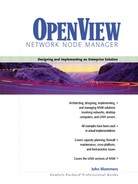Manually Guided Discovery
Given that you have now discovered the initial management domain, our next step might well be to cautiously manage (using the pulldown menu Edit:Manage Objects) a few subnets connected to the local routers. This expands the management domain accordingly, which will trigger NNM to autodiscover within these new subnets. Assuming the SNMP community strings are already defined in NNM, new routers will undoubtedly be discovered in the newly managed subnets, and the Internet submap will sprout new routers with new unmanaged subnets attached. By proceeding carefully while allowing the autodiscovery process to converge, it is possible to manually guide NNM through the desired management domain. This process may add a few hours to the discovery process, but it is a controlled friendly process that can be reversed at any point by unmanaging (using the pulldown menu Edit:Unmanage Objects) unwanted portions of the network map.
Another advantage of a manually directed discovery is that any troublesome SNMP agents will be easier to identify. For example, if you just managed a subnet, and a minute later (after discovery has stabilized) the netmon daemon core dumps, then it’s immediately clear where the problem device is located.
If you want to study the impact of autodiscovery on a Cisco router CPU, you can monitor the busyPer MIB variable and observe how it rises and falls as NNM harvests its ARP cache, routing table, and interface table. You can use the MIB browser for this purpose (Tools:SNMP MIB Browser) and press the graph button to automatically poll and graph this data.This type of data is helpful in educating network managers about the impact NNM will have on their routers, and reassure them that it won’t hurt their normal operation one bit.
Another advantage of manually directed discovery is that you will find all kinds of errors along the way, one at a time. An icon may be missing, a community string may be incorrect, a switch may have old firmware that limits NNM’s autolayout capabilities, or a device may incorrectly pass the discovery filter because of a typo.
A final advantage of a manually guided discovery is that devices that are hard to discover are characterized. For example, devices that don’t communicate with other devices on remote subnets won’t have ARP cache entries in the local routers. In such cases, just manually pinging these devices on the NNM system will let NNM discover them. This is because the netmon daemon listens on a raw ICMP (internet control message protocol) socket, picks up the pinging activity, and harvests the responding device’s IP address.
Initially, as new subnets and routers are discovered and managed, you will want to allow NNM to redraw the Internet submap. At some point, however, as this map becomes cluttered, you should turn autolayout off for the Internet submap and drag icons into appropriate positions. This is fairly painless because you’re in total control of the discovery process.
